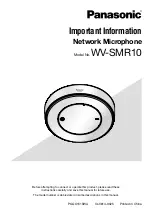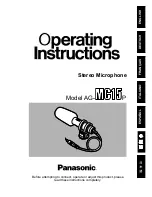
6
7
KMR 81 i
The assignment of the microphone terminals and
the modulation polarity at the power supply out-
put are identical to those at the microphone.
2.4 Operation with Unbalanced or
Center Tap Grounded lnputs
The BS 48 i, BS 48 i-2 and N 248 phantom 48 Vdc
power supplies are dc-free so that no transformer
is required for connection to unbalanced inputs.
In the case of the KMR 81 i condenser microphone
pin 2 is the “hot phase“, in accordance with the
standard, and pin 3 of the output of the power sup-
ply must be connected to earth (see Fig. 1).
In the case of many other phantom powering units
(except those mentioned above), not only the mod-
ulation leads to the microphone, but also the out-
going modulation leads from the powering unit,
are at the potential of the feed voltage (+48 V).
This is of no significance for the balanced, float-
ing amplifier and mixing
console inputs in general
studio use. On the other
hand, the feed voltage
will be short-circuited
when connected to sin-
gle-ended or center tap
grounded amplifier in-
puts, and no operation
will be possible. This can
be circumvented as fol-
lows:
a) In center tap ground-
ed equipment with input
transformer (e.g. some
NAGRA units), the earth
lead can almost always
be disconnected without
affecting the function of
the equipment.
b) In every outgoing
modulation lead, an RC
net-work can be incorpo-
rated to block the 48 Vdc
voltage (See Figure 2 and
Neumann-Information no.
84 222).
Die Zuordnung der Mikrophonanschlüsse und die
Polarität der Modulationsadern ist am Ausgang der
Speisegeräte die gleiche wie am Mikrophon.
2.4 Betrieb an unsymmetrischen oder
mittengeerdeten Eingängen
Die 48 V-Phantom-Speisegeräte BS 48 i, BS 48 i-2
und N 248 haben gleichspannungsfreie Ausgänge,
so dass für den Anschluss an unsymmetrische Ein-
gänge kein Übertrager erforderlich ist.
Beim KMR 81 i ist Pin 2 normgemäß die „heiße
Phase“. Für unsymmetrische Eingänge muss PIN 3
am Ausgang des Speisegerätes an Masse gelegt
werden (siehe Abbildung 1).
Bei vielen anderen als den o.g. Phantomspeisege-
räten liegen nicht nur die Modulationsleitungen
zum Mikrophon auf dem Potential der Speisespan-
nung von +48 V, sondern auch die vom Speisege-
rät abgehenden Modulationsleitungen. Für die in
der Studiotechnik allgemein üblichen symmetri-
schen und erdfreien Ver-
stärker und Mischpultein-
gänge ist dies ohne Be-
deutung. Dagegen wird
die Speisespannung beim
Anschluss an einseitig
oder mittengeerdete Ver-
stärkereingänge kurzge-
schlossen, und es ist kein
Betrieb möglich. Dann be-
stehen
folgende
Lö-
sungsmöglichkeiten:
a) In mittengeerdeten
Geräten mit Eingangs-
übertrager (z.B. einige
NAGRA-Geräte) kann die
betreffende Erdverbin-
dung fast immer ohne
Nachteile für die Funkti-
on des Gerätes aufge-
trennt werden.
b) In jede abgehende
Modulationsleitung kann
zur Abblockung der 48 V-
Gleichspannung eine RC-
Kombination eingefügt
werden (siehe Abbildung
2 und Neumann-Informa-
tion Nr. 84 221).
Abbildung / Figure 2
Abbildung / Figure 1
3.
Technische Daten
Akustische Arbeitsweise ........... Druckgradienten-
interferenzempfänger
Richtcharakteristik ................... Superniere/Keule
Übertragungsbereich .................... 20 Hz...20 kHz
Feldübertragungs-
faktor
1)
................................... 18 mV/Pa ± 1 dB
Nennimpedanz..................................... 150 Ohm
Nennlastimpedanz.............................. 1000 Ohm
Geräuschpegelabstand
CCIR 468-3 .............................................. 71 dB
Geräuschpegelabstand
DIN/IEC 651 ............................................. 82 dB
Ersatzgeräuschpegel
CCIR 468-3 .............................................. 23 dB
Ersatzgeräuschpegel
DIN/IEC 651 .......................................... 12 dB-A
Grenzschalldruckpegel für
0,5 % Klirrfaktor
2)
.................................. 128 dB
0,5 % Klirrfaktor mit Vordämpfung
2)
......... 138 dB
Max. Ausgangsspannung ......................... 1,3 dBu
Speisespannung
3)
.............................. 48 V ± 4 V
Stromaufnahme
3)
..................................... 0,8 mA
Erforderlicher Steckverbinder .................. XLR 3 F
Gewicht .................................................... 145 g
Durchmesser ............................................ 21 mm
Länge ................................................... 226 mm
1 Pa = 10 µbar
0 dB 20 µPa
1)
bei 1 kHz an 1 kOhm Nennlastimpedanz. 1 Pa
94 dB SPL.
2)
Klirrfaktor des Mikrophonverstärkers bei einer Eingangsspan-
nung,
die der von der Kapsel beim entsprechenden
Schalldruck abgegebenen Spannung entspricht.
3)
Phantomspeisung (P48, IEC 1938).
3.
Technical Specifications
Acoustical op. principle ............. Pressure gradient
interference transducer
Directional pattern ..... Supercardioid/Lobe shaped
(Shotgun)
Frequency range .......................... 20 Hz...20 kHz
Sensitivity
1)
............................ 18 mV/Pa ± 1 dB
Rated impedance ................................. 150 ohms
Rated load impedance ....................... 1000 ohms
S/N ratio
CCIR 468-3 .............................................. 71 dB
S/N ratio
DIN/IEC 651 ............................................. 82 dB
Equivalent SPL
CCIR 468-3 .............................................. 23 dB
Equivalent SPL
DIN/IEC 651 .......................................... 12 dB-A
Maximum SPL
for 0.5 % THD
2)
...................................... 128 dB
for 0.5 % THD with preattenuation
2)
......... 138 dB
Max. output voltage ................................ 1.3 dBu
Supply voltage
3)
................................ 48 V ± 4 V
Current consumption
3)
.............................. 0.8 mA
Matching Connector ................................. XLR 3 F
Weight ...................................................... 145 g
Diameter ................................................. 21 mm
Length .................................................. 226 mm
1 Pa = 10 µbar
0 dB 20 µPa
1)
at 1 kHz into 1 kohm rated load impedance.
1 Pa
94 dB SPL.
2)
THD of microphone amplifier at an input voltage equivalent to
the capsule output at the specified SPL.
3)
Phantom powering (P48, IEC 1938).



























